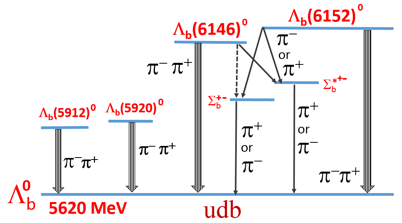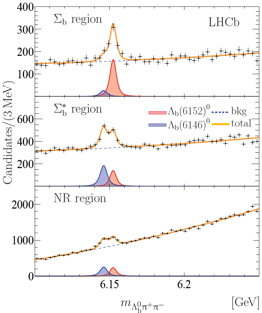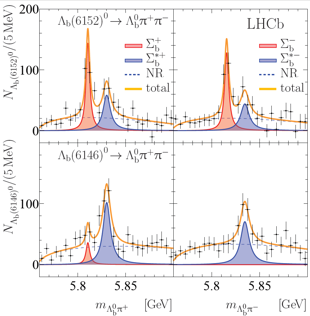Today at the EPS-HEP conference, the LHCb collaboration announced the discovery of two new beauty baryon particles. These particles are interpreted as excited states of the Λb0 baryon. The new structures are observed in the Λb0π+π– spectrum using the full LHCb Run 1 and Run 2 data set, corresponding to an integrated luminosity of 9fb-1.
The lightest baryon, the proton, which is the nucleus of the hydrogen atom, is composed of three light quarks uud while its neutral partner the neutron is composed of udd quarks. By replacing one of the d quarks by a heavier strange quark s we obtain a Λ0 particle composed of uds quarks. Furthermore by replacing in the Λ0 baryon the s quark by a charm quark c or a beauty quark b we obtain a Λc+ or a Λb0 baryon particle. The three quarks udb forming the Λb0 are in their lowest quantum mechanical state. Like electrons in atoms quarks can form excited states with different values of angular momentum and quark spin orientation. Earlier, in 2012, LHCb announced the observation of the two excited states of Λb0 baryon, Λb(5912)0 and Λb(5920)0, discovered in the Λb0π+π– invariant mass spectrum.
In the analysis reported today Λb0 baryons are formed from Λc+π– combinations, where the Λc+ baryon is reconstructed using its pK–π+ decay. Λb0→J/ψK– decays, with J/ψ→μ+μ–, are also used as a cross-check. The left image below shows the Λb0π+π– invariant mass spectrum with Λb0 baryons reconstructed in these two cases. A clear peaking structure is observed at a mass of around 6150 MeV in both cases.
Since the mass of the new structure is above the thresholds (minimum invariant mass) of both the Σb±π∓ and Σb*±π∓ combinations, it can potentially decay via these intermediate resonances. To investigate this the Λb0π+π– mass spectrum is studied in the Λb0π± mass regions populated by the Σb(*)± resonances. The data with Λb0→Λc+π– are split into three samples: events with a Λb0π+ mass around the Σb± mass region, around Σb∗± mass region and the remaining nonresonant (NR) ones. The Λb0π+π– mass spectra in these three samples are shown in the central image above. The spectra in the Σb and Σb* regions look different and suggest the presence of two narrow peaks at different masses, denoted in the LHCb result as Λb(6146)0 and Λb(6152)0. The right image above shows the corresponding Λb0π+ and Λb0π– invariant mass spectra in the decays of new particles. As well as nonresonant component, clear contributions from intermediate resonances are visible: Λb(6152)0→Σb±π∓, Λb(6152)0→Σb*±π∓ and Λb(6146)0→Σb*±π∓. No significant evidence is found for Λb(6146)0→Σb±π∓.
The masses of the two states measured in this analysis are consistent with theoretical predictions for the 1D doublet of Λb0 states. While the newly discovered states are denoted as Λb0, their interpretation as other excited beauty baryons, such as neutral Σb0 states, can not be excluded.
Recently LHCb physicists reported the first observation of the two new mass peaks in the Λb0π+ and Λb0π– invariant mass spectrum consistent with the excited Σb(6097)± charged baryon.
Read more in the LHCb EPS-HEP presentation and in the LHCb paper.




